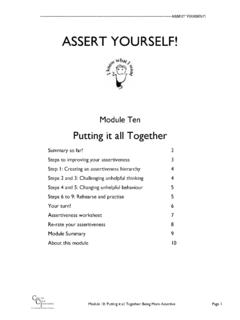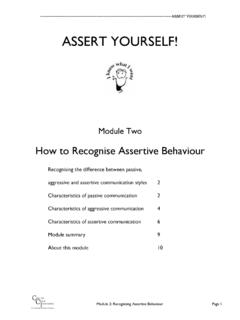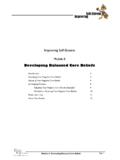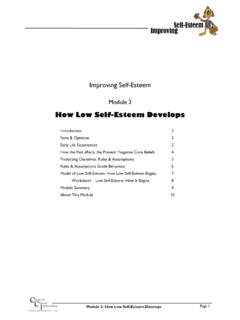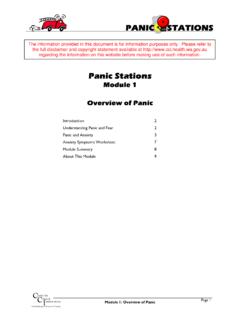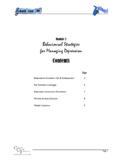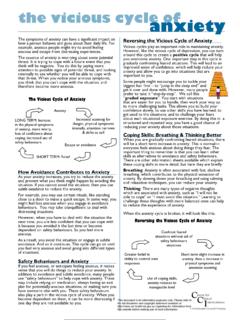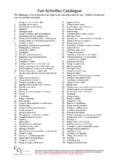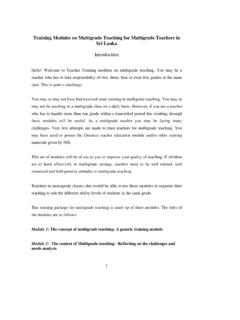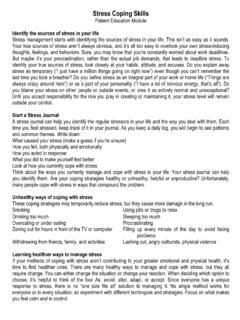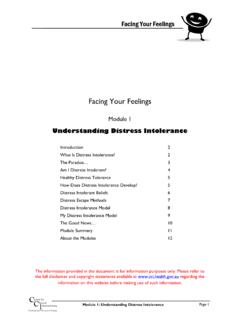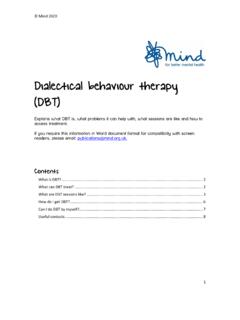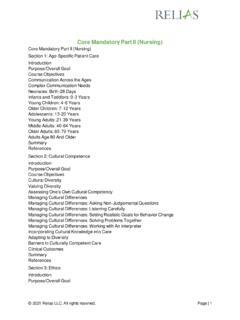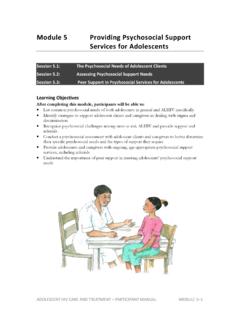Transcription of Facing Your Feelings - cci.health.wa.gov.au
1 Facing your Feelings Facing your Feelings module 3 Improving Distress Introduction 2 Balancing Acceptance & Improvement 2 Improving Distress 2 Opposite Action 3 Distress Improvement Activities 4 Improving Distress Practice 7 Problem Solving 8 module Summary About the Modules 14 15 Facing your Feelings The information provided in the document is for information purposes only. Please refer to the full disclaimer and copyright statements available at regarding the information on this website before making use of such information. Page 1 Psychotherapy Research Training C C I entre for linical nterventions module 3: Improving Distress Facing your Feelings Introduction The previous module focused on developing ways of accepting emotional distress. This module takes a very different focus of learning how to improve your distress when you experience it. To improve distress we focus more on your behaviours, looking at what to do and what not to do when you experience emotional distress.
2 Depending on the type of escape methods you typically use ( , avoidance, numbing & withdrawing, or harmful releases), the strategies we will suggest for improving your distress will vary slightly. This module will focus on helping you discover a variety of things you can try to improve your distress, so you can experiment and find out what works for you. Balancing Acceptance & Improvement Accepting and improving distress are quite different approaches, and maintaining a balance between acceptance and improvement is the key to building distress tolerance. It is unhelpful to be at either extreme ( , only accepting how you feel or only trying to improve how you feel). To tolerate distress you really need to learn how to do both. Our aim is to help you learn how to accept your negative emotions, and with that in mind, then work on improving your emotional experience. Imagine if you only tried to improve your distress without being able to accept it first, if this were the case then your efforts to find something to improve your negative Feelings would be pretty frantic and desperate.
3 If instead you could accept your distress, then your efforts to improve the distress would more likely be calm, considered and calculated. We have purposely put Accepting Distress before Improving Distress in this series of Modules, as we don t want improving to become just another strategy for avoiding your emotions. In summary, you need to feel the emotion first, accept it, ride through it, and then take action to improve it. However having said that, if as you work through these modules the distress you experience is extremely intense and unbearable emotional pain, then you may not be able to apply the acceptance strategies outlined in the previous module just yet. If this is the case, then it is ok to move straight to this module and focus on improving your distress (particularly the Distress Improvement Activities on page 5). This is particularly relevant for people who engage in self-harm or drug and alcohol use to manage their distress. In these situations, temporary distractions may be necessary to help you get through the intense distress you might be experiencing, and avoid engaging in behaviours that are damaging to you.
4 Improving Distress As we have seen, being distress intolerant can manifest is very different sorts of behaviours or escape methods. Some people avoid certain situations that make them distressed, engage in reassurance seeking or checking to alleviate their distress, or use distraction and suppression to stop their distress. Other people numb and withdraw via engaging in alcohol or drug use, binge eating or using sleep to escape their emotions. And other people may engage in harmful releases, hurting themselves in some physical way as a means of dealing with their distress. Although these behaviours are very different, and hence the strategies for improving distress can vary too, the common guiding principle for improving distress is to do the opposite of your escape urge, and find specific activities that improve your emotional state. Please Note: As mentioned in module 1, whilst these modules may be helpful to people who use drugs, alcohol or self-harm as a means of tolerating emotional distress, it is important to recognise that these are very serious problems in their own right that can cause a person significant harm.
5 We strongly advise seeking help from a GP or mental health professional to address these concerns, rather than relying solely on these Modules to overcome the problem. Avoid Situations Alcohol or Drugs Distress Distraction & Suppression Reassurance Seeking or Checking Self Injury Binge Eating Sleep Page 2 Psychotherapy Research Training C C I entre for linical nterventions module 3: Improving Distress Facing your Feelings Opposite Action In module 1, you identified your particular escape methods. Below is a table summarising the opposite actions for each distress escape method we have covered. Look through the table and circle the opposite action box corresponding to your particular escape method(s). There is also a box at the bottom for if you engage in a particular escape method that we have not covered in these Modules. If this applies to you, maybe you could try to think of what the opposite action would be. Drop Escape Method Do Opposite Action Situational Avoidance* Don t avoid situations that distress you.
6 Instead gradually face these situations and stay in them, until you have ridden through the distress. Remember to reward your efforts when you are done, by doing things that are active or soothing. Reassurance Seeking or Checking Minimise or eliminate reassurance seeking or checking behaviours. Try to cope independently with the distress you feel, riding through these Feelings without resorting to checking things or seeking the reassurance of others. Remember to reward your efforts when you are done, by doing things that are active or soothing. Distraction & Suppression Don t push away distressing Feelings . Instead allow and experience these Feelings . Remember to reward your efforts when you are done, by doing things that are active or soothing. Alcohol or Drugs Don t numb the distress by using alcohol or drugs. Instead allow and experience these Feelings . Also do things that are active or soothing, rather than withdrawing from life. Binge eating Don t numb the distress by binge eating.
7 Instead allow and experience these Feelings . Also do things that are active or soothing, rather than withdrawing from life. Excessive sleep Don t numb the distress by using sleep. Instead allow and experience these Feelings . Also do things that are active or soothing, rather than withdrawing from life. Harmful Releases Self-soothe and be active in the moment, rather than harming yourself. * Note: This module deals with general avoidance driven by not wanting to feel emotional distress. If you identify very strongly with your avoidance being specifically related to social situations, or fear of having a panic attack or fear of having a serious health problem, then you may want to look at the Shy No Longer , Panic Stations and Helping Health Anxiety Information packages respectively to target these specific problems. Page 3 Psychotherapy Research Training C C I entre for linical nterventions module 3: Improving Distress Facing your Feelings You will notice that most of the opposite actions initially require that you stay with, ride through, allow and experience the distress, rather than escaping it.
8 As such, the acceptance strategies of module 2 will be relevant in helping you do this. You will also notice that most of the opposite actions require engaging in some activity that is either about being active in the moment, or about soothing yourself in some way. The Distress Improvement Activities that follow this section will help you with ideas for activities that may help you achieve these aims. Also notice that for the first 3 escape methods ( , situational avoidance, reassurance seeking or checking, distraction & suppression), distress improvement activities should be used as a reward after having faced and stayed with the distress until it naturally subsides of its own accord. For the remaining escape methods, engaging in distress improvement activities may be done sooner than this, as you do not necessarily have to wait until you feel the distress subside. It is also worth mentioning that doing these opposite actions can be challenging, and so words of encouragement and compassion to ourselves may be important when we are finding it tough.
9 It can be useful to think what encouragement would I give to someone else feeling this way? , what would I say to them and what tone would I use? Some other examples of helpful self-talk might be things I can stay with this feeling ; it is good practice for me to get comfortable being uncomfortable ; I can get through this ; I can tolerate this ; It will pass ; this is good for me in the longrun ; I can focus on just getting through this moment ; I can breathe with this feeling ; this is helping me build my tolerance .. Distress Improvement Activities Finding small ways to participate and be active in the moment when distressed, or to self-soothe and self-nurture when you are feeling distressed, are important for improving your emotional experience. Activities that centre on the concepts of activating and soothing we will call distress improvement activities , and a list of these is featured on the next page. The activities in the left-hand column are more about participating actively in the moment ( , being involved, active and absorbed in something that may improve your distress), whilst the activities on the right-hand side are more about soothing yourself ( , activities that make us feel a sense of warmth and being cared for and that help us get through things).
10 You will notice there is a lot of overlap between activities that are about activation and activities that are about soothing, so don t get too caught up in which column you pick activities from. Also, some of the listed activating and soothing activities you may also find rewarding, and you can use them in this way if needed. The idea is not that you have to use each activity on the list, but that some may appeal to you to try and others won t. Also, by having such a large list, it may help you to brainstorm other distress improvement activities that may work for you. Look at the list and underline any activities you may like to experiment with when you are feeling distressed, and feel free to add other activities that come to mind in the space provided. Remember, the aim of these activities is not to take your distress away, but to make your distress more tolerable. I can get through this! Page 4 Psychotherapy Research Training C C I entre for linical nterventions module 3.
